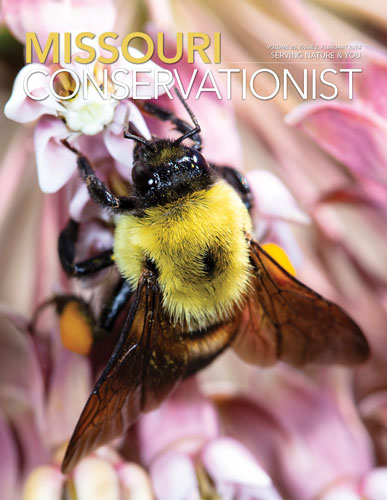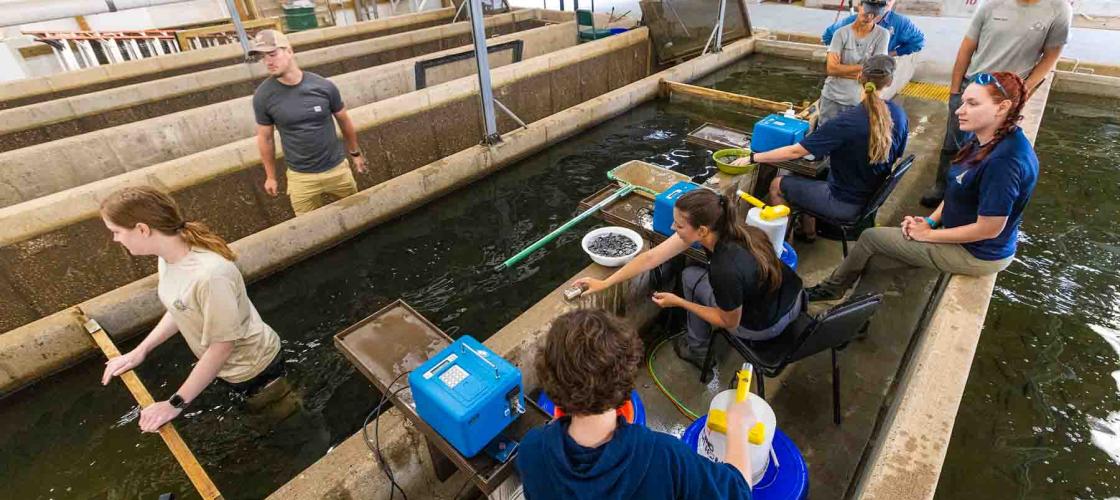
You won’t find a dissolved oxygen meter or a Secchi disk in an angler’s tackle box. Nor will you see a UV disinfection device or a fish egg sorter.
However, in terms of fishing success, these items are as integral to improving the chances of reeling in some of Missouri’s popular sportfish as crankbaits, jigs, and hand-tied flies. Because of the important role MDC’s fish hatcheries play in sustaining a number of sportfish populations, behind-the-scenes aquatic science has become as important to Missouri’s fishing success as on-the-water angler savvy.
“MDC hatcheries play a vital role in fisheries management plans to support sportfish populations in waterbodies throughout the state,” said MDC Hatcheries Systems Manager Clint Hale. “Many fishing experiences would simply not be possible without the work of MDC’s hatcheries.”
To be clear, not every Missouri fish’s story has a lineage that traces back to the raceways and rearing ponds of an MDC hatchery. The spawning journeys walleye and white bass make each March and the crappie spawn in April are examples of naturally occurring fish propagation events that anglers across the state set their calendars by each year.
However, along with nature, human-made nurture also provides boosts to several of the state’s fish species. On an annual basis, MDC hatcheries produce more than 4 million fish representing 10 different species (see sidebar on Page 25). This infusion of variety isn’t just about making sure there are large numbers of fish in Missouri’s waters. It’s also about making sure there are large numbers of people trying to catch them.
“Hatcheries increase recruitment, retention, and reactivation of anglers through stockings and public outreach,” Hale said.
MDC’s fish hatcheries fall into two categories, warm-water and cold-water. In addition to adding variety to Missouri’s fishing opportunities, some of MDC’s warm-water and cold-water hatcheries also are great places to visit. MDC’s five cold-water hatcheries (Bennett Spring near Lebanon, Roaring River near Cassville, Montauk near Salem, Maramec Spring near St. James, and Shepherd of the Hills near Branson) raise rainbow trout and brown trout that are released at their fishing areas and at trout management areas across the state.
MDC’s four warm-water hatcheries (Lost Valley near Warsaw, Chesapeake near Mount Vernon, Blind Pony near Sweet Springs, and Hunnewell in Shelby County) provide a variety of sportfish. Some of the species they produce — such as walleye, channel catfish, and bluegill — are used to enhance natural-reproducing populations at reservoirs throughout the state. Other species — such as paddlefish and muskie — are raised and added to populations that experience little or no natural reproduction in Missouri waters.
Some of the state’s warm-water hatcheries are also used to sustain threatened species such as Topeka shiners and lake sturgeon.
Cold-Water Hatcheries
Rainbow trout are the species raised at all of MDC’s cold-water hatcheries. In addition to rainbow trout, brown trout are also raised at Shepherd of the Hills Hatchery.
Raising trout from egg to a stocking size of 12.5 inches is a two-year process that starts in late fall or early winter. It begins with eggs being taken from gravid females and fertilized with milt (the trout equivalent of sperm), which is extracted from the males.
Fertilized eggs are put in specialized incubation holders — called up-welling jars — where their progress is monitored and manipulated to produce hatching success. When hatching occurs, the tiny sac-fry (the term used for newborn fish) are put in special holding tanks inside the hatchery building. Here the combination of frequent feedings and the regulation of light and temperature transform the sac-fry to swim-up fry in 14–18 days. From swim-up fry, they grow to fingerlings, then subadults, then to 12-inch fish that are ready to be stocked.
Serving as the foundation of operation at each MDC cold-water hatchery is a steady supply of cold water. At Bennett Spring, Roaring River, Montauk, and Maramec Spring hatcheries, the cold water comes from naturally occurring springs. At Shepherd of the Hills Hatchery, the cold water is the result of water that comes from the bottom of Table Rock Lake and gets released through Table Rock Dam to the hatchery and the adjacent Lake Taneycomo.
Neither rainbow trout nor brown trout are native to Missouri. The cold-water conditions that exist at MDC hatcheries mirror the water conditions found in trout’s native habitat (northern California and the Pacific Northwest for rainbow trout, Europe and parts of Asia for brown trout). Since their introduction to Missouri and other states, trout have become extremely popular.
“Trout are popular with anglers for a number of reasons,” said Allen Brandes, who is the retired hatchery systems supervisor for MDC’s cold-water hatcheries. “Trout inhabit some of the most beautiful and pristine areas in the state. Also, tying your own flies is a hobby practiced by many who pursue trout. Being able to catch trout on a lure created by your own hands attracts many anglers to this sport. Some anglers simply chase trout for their taste, which can be prepared in numerous recipes by a variety of cooking methods.”
Species Hatched in MDC Hatcheries
On an annual basis, MDC hatcheries produce more than 4 million fish representing 10 different species:
- Trout*: 1,658,000
- Walleye: 1,700,000
- Channel catfish: 260,000
- Bluegill: 25,000
- Sunfish: 45,000 hybrid
- Paddlefish: 60,000
- Blue catfish: 3,000
- Hybrid striped bass: 265,000
- Muskie: 6,800
- Lake sturgeon: 10,000
*1,620,000 rainbow trout, and 38,000 brown trout
Making a Fish
An interesting and extremely popular product of MDC’s warm-water hatchery system are hybrid sunfish. These fish, which range in size from 6–7.5 inches and are used for stockings at fishing events throughout the state, all have their beginnings at a hatchery. Here’s the recipe:
Male bluegill are paired with female green sunfish in a hatchery pond each spring. They will spawn throughout the summer, often producing more than 100,000 hybrid fish offspring.
These offspring are fed in the same pond and most of them usually attain a size of 2–5 inches by the end of their first summer and some will grow to 6 inches. The following spring, these fish are removed from the pond and separated by size. The fish 6 inches and larger are used for stocking in the early spring. The 4–6-inch fish are put back into a hatchery pond for further growth and potential stocking in late spring and/or early fall. The 2–4-inch fish are also put into hatchery ponds for further growth so they can be stocked in the coming fall or the following spring.
“If you’re trying to get a kid interested in fishing, this is the species you want,” Blind Pony Hatchery Manager Nathan Storts said of the hybrid sunfish. “They bite so well that they practically bite themselves out of existence until more are created.”
Warm-Water Hatcheries
MDC’s warm-water hatcheries perform a variety of functions in the state’s fish production system, but the bulk of the fish they produce fulfill three basic needs:
Restoration stockings: These are stockings where fish are put in a body of water that is lacking in these species, such as a new or renovated reservoir that needs to be stocked with specified species (in the correct ratio) to get the reservoir on the road to becoming a productive fishery.
Special event stockings: These stockings are primarily in the spring and summer and consist of hybrid sunfish and channel catfish that are stocked to enhance the fishing opportunity for the event’s participants.
Supplemental stockings: These are the most common destinations for fish raised at MDC’s warm-water hatcheries. Supplemental stockings help maintain populations of popular sportfish species at desired levels. The need for these stockings can be for a variety of reasons, depending on the management goals for the population structure at a specific reservoir or stream.
“Sometimes it’s because fishing pressure is greater than the natural production occurring on that body of water,” said Rich Cook, who is the hatchery systems supervisor for MDC’s warm-water hatcheries. “Other times, these stockings are brought about by land alterations, such as dams that restrict fish movement to historical spawning areas.”
Some of the technology that has been incorporated into the fish-rearing process at warm-water hatcheries include dissolved oxygen meters, paddle-wheel aerators, microscopes, sonograms, and monitoring systems that check critical parameters on a continuous basis. The key to raising fish successfully at warm-water hatcheries is combining human technology and scientific strategies with nature’s cycles.
“Our warm-water hatcheries are strictly driven by the seasons,” said Kurt Hentschke, the manager at MDC’s Hunnewell Hatchery. “The warm-water species spawn once each year, which means staff have one shot each year to meet production goals. Our warm-water hatcheries raise several different and unique species each year. Most require species-specific culture practices, all of which must progress simultaneously.”
One feature that differentiates warm-water hatcheries from cold-water hatcheries is the water structures where the fish are raised. Warm-water hatcheries have mostly ponds, while cold-water hatcheries have concrete raceways.
“Most warm-water species are raised in ponds,” said Nathan Storts, the manager of MDC’s Blind Pony Hatchery, which is one of only three hatcheries in the U.S. that raises paddlefish. “This is because warm-water species require much more space to achieve growth and to maintain healthy populations.”
Whether it’s a warm-water or cold-water facility, the journey of a fish through a hatchery has several challenges that hatchery workers must be on the watch for at all times.
One of those challenges is weather. Too much rain can cause poor water quality due to flooding. Too much flow into a pond can prevent staff from being able to collect broodstock.
Warm-water hatcheries also must work with, and sometimes overcome, weather-related temperature fluctuations.
“Cool, cloudy weather can affect plankton production, which is what newly stocked fry will be eating,” said Cook. “This will result in a lower abundance of available food. Hot and cloudy weather can result in low dissolved oxygen in the ponds. This could require supplemental oxygen and/or flushing with fresh water.”
But the challenges of an MDC fish hatchery aren’t restricted to weather-related issues.
“Probably one of the biggest challenges is to have a source of water that provides an adequate and steady supply of water. That water must have good quality,” Cook said. Biosecurity is also a constant task to prevent the introduction and/or spread of any kind of bacteria, virus, or any other type of disease-causing organism.
“Fish in a hatchery setting are in higher densities than what are found in the wild,” he said. “Hatchery staff are trained to recognize and provide treatments for fish health issues they encounter. MDC also has staff trained in fish health that will identify issues and give recommendations on treatment options.”
Put everything together that takes place in MDC’s cold-water and warm-water hatcheries and the result is a system designed to keep pace with the biological and recreational fish demands of the state. It’s a conservation version of supply and demand.
“Fish hatchery production systems try to meet annual stocking requests to sustain sport fisheries statewide,” said Drew Burdick, the manager of MDC’s Lost Valley Hatchery. “In other words, our role is to provide a high-quality product to the public and other stakeholders ensuring that Missourians have sustainable populations of these sportfish.”
The reward of these labors are what anglers reel in at the state’s lakes and streams.
“MDC’s fish hatchery jobs are rewarding because we are actually making a difference in fish populations and in some individuals’ quality of life,” Hale said.
“I enjoy seeing people out fishing or seeing pictures of catches of those species that we raise and stock,” Cook said. “It is a good feeling knowing that a fish that was caught might be one that we raised and released.”
MDC’s warm-and cold-water hatcheries keep Missouri’s waterways stocked.
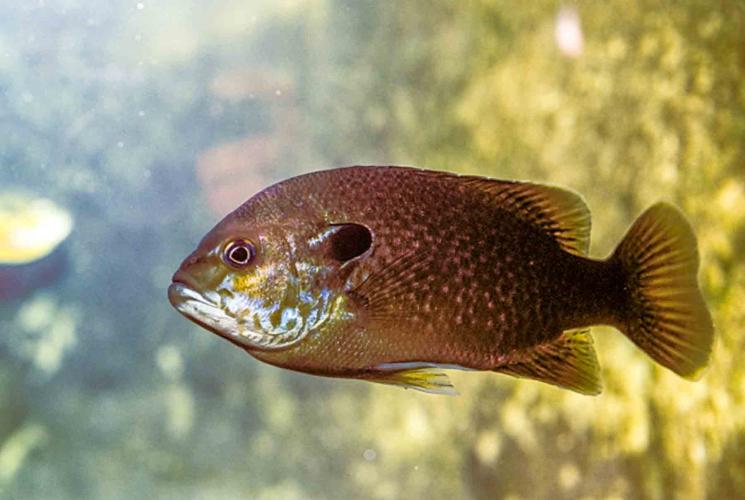
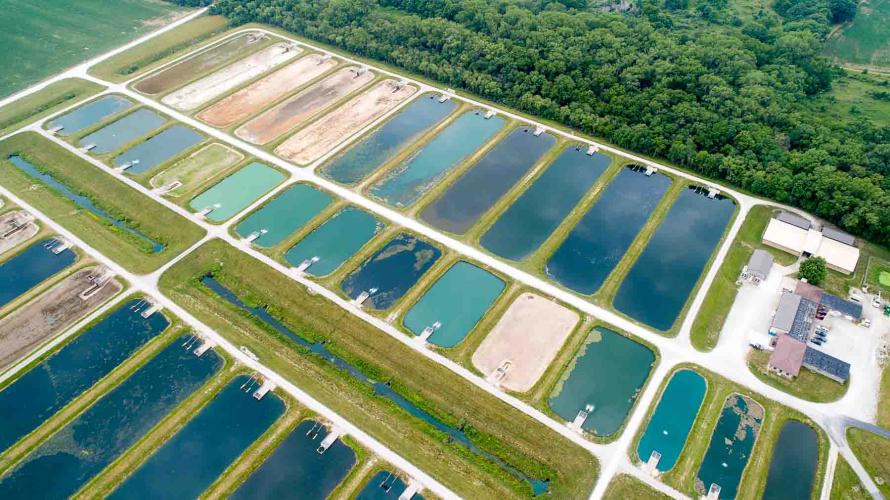
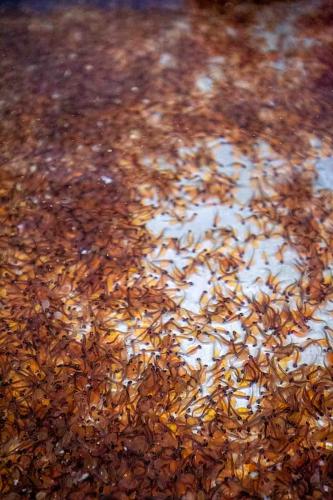
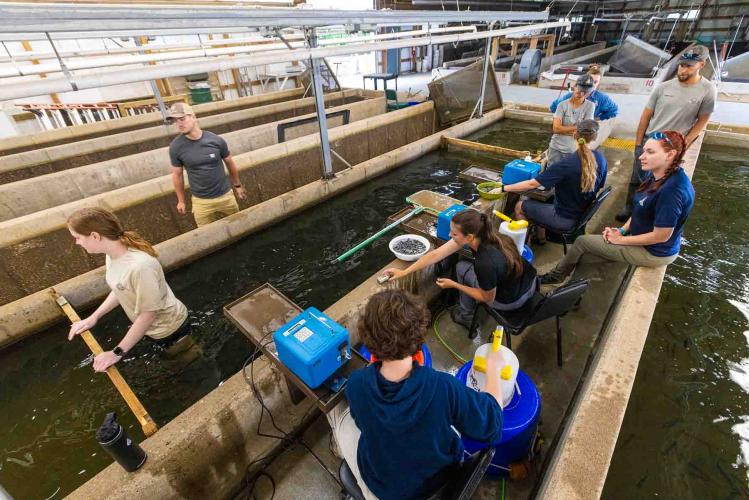
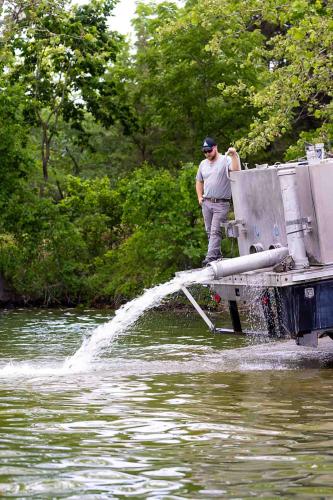
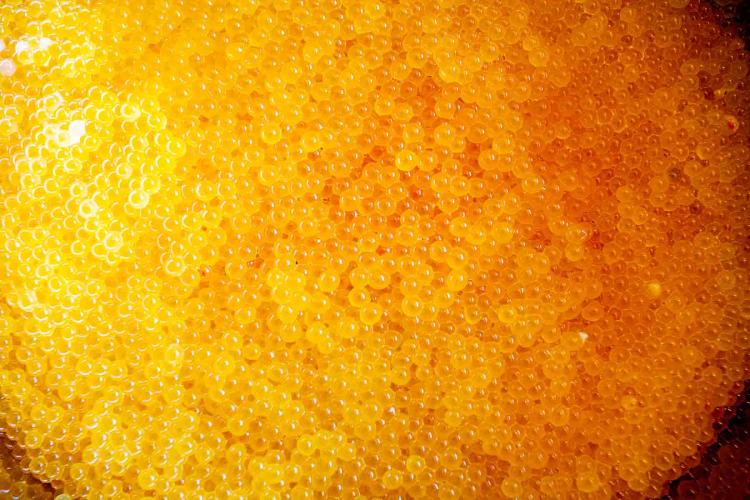
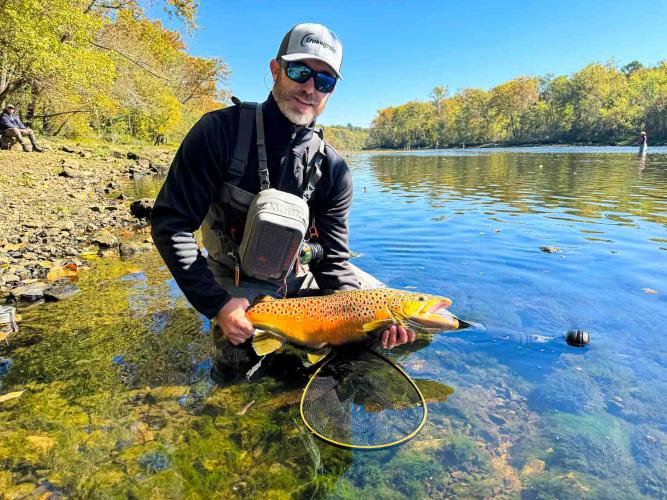
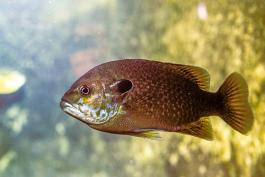
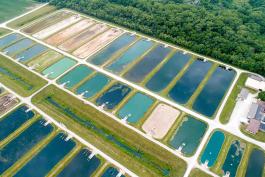

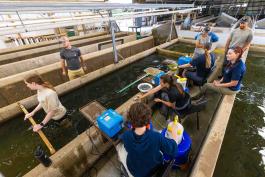
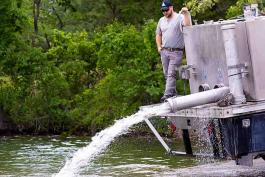

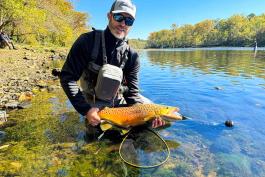
Also In This Issue
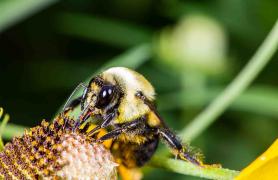
Bumble Bee Atlas improves understanding, conservation of threatened species.

Containers offer native plant options for limited landscapes.
And More...
This Issue's Staff
Editor - Angie Daly Morfeld
Associate Editor - Larry Archer
Photography Editor - Cliff White
Staff Writer - Kristie Hilgedick
Staff Writer - Joe Jerek
Staff Writer – Dianne Van Dien
Designer - Shawn Carey
Designer - Marci Porter
Photographer - Noppadol Paothong
Photographer - David Stonner
Circulation – Marcia Hale






















